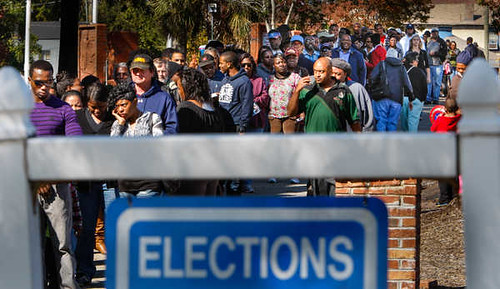By Christie Thompson, ProPublica
In his State of the Union address, President Obama returned to a point he'd made on election night: The need to do something about long voting lines. Obama announced his plan for a commission to "improve the voting experience in America."
But often missing from discussions about how to make voting easier is the rapid expansion of absentee balloting. Letting people vote from home means fewer people queuing up at overburdened polling places. So why hasn't vote-by-mail been heralded as the solution?
When it comes to absentee and mail-in voting, researchers and voting rights advocates aren't sure the convenience is worth the potential for hundreds of thousands of rejected ballots.
Although Oregon and Washington are the only two states to conduct elections entirely by mail, absentee voting has expanded rapidly nationwide. Since 1980, the number of voters using absentee ballots has more than tripled. Roughly one in five votes is now absentee.
Twenty-seven states and the District of Columbia allow voters to request an absentee ballot for any reason, according to the National Conference of State Legislatures. That's up from the six states that did so in 1988, according to the Pew Charitable Trusts.
Rare cases of voting fraud are more likely to be through absentee ballots, The New York Times reported last fall, citing comment from some election officials. Compared to in-person voting, an absentee ballot also is more likely to be rejected.
Yet few legislators proposed restrictions on absentee and mail-in voting to prevent fraud during the wave of voter ID laws introduced in the last election. Some point to partisan politics, as Republican voters traditionally have been more likely to vote absentee while Democrats tend to turn out early to vote in-person.
Proponents of mail and absentee voting say it can encourage higher voter turnout. Last November, Oregon had the sixth-highest voter turnout of eligible voters in the country, though the five states with higher turnout had a mix of mail and in-person voting. Mail-only elections also require fewer staff and resources, said professor Paul Gronke, director of the Early Voting Information Center at Reed College in Portland, Ore.
The effect of absentee voting on wait times is unclear. Nationwide, line lengths have stayed fairly steady over the last 10 years.
In Florida, more than 28 percent of the nearly 8.5 million ballots cast in the last election were from absentee voters, up nearly 6 percentage points from 2008. In anticipation of discouragingly long lines, the Obama team ran a "Vote Now!" campaign endorsing early and absentee voting. Yet many Florida voters still reported standing in line for hours.
The long wait times were likely the result of cutbacks in early voting days and an unusually lengthy ballot, said Dartmouth professor Michael C. Herron, who with another researcher studied the effect of early voting restrictions in Florida last year.
Herron found that the rise of absentee voting in Florida was the result of long lines and expressed concern about the high number of rejected absentee ballots. Overall, nearly 23,000 of Florida's absentee votes were thrown out in the last election.
"If the solution is to shunt people into a process that has a 1 percent rejection rate, that could be a lot of people," he said.
Like long lines, ballot rejection can disproportionately affect voters of color. In Florida, African-American voters who voted absentee were nearly twice as likely to have their ballot rejected as white absentee voters, Herron found. Vote-by-mail can also make it more difficult for low-income voters, who are more likely to move, to stay on top of registration requirements, Gronke said.
Gronke said he believes states that conduct all elections via mail are able to do a better job making sure votes get counted. Voters in Oregon have also been voting by mail ballot since 1998 and have a better handle on the system, he said.
Voting rights activists aren't trumpeting mail-in voting as the best answer. Elisabeth MacNamara, national president of the League of Women Voters, said increasing early voting is not a priority. Instead, the League has focused on expanding online registration and securing more days of in-person early voting, she said.
"Is that a true 21st century solution to modernizing our election process, given the fact that fewer and fewer people are using the mail?" MacNamara said. Of vote-by-mail, she said, "I'm not sure this is going to be a long-term solution."


















